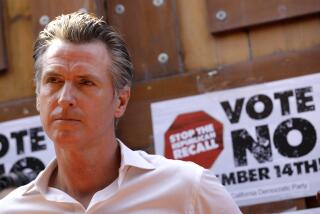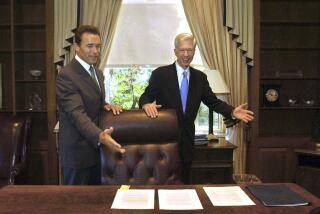Recall Idea Got Its Start in L.A. in 1898
The year was 1910, and the Southern Pacific Railroad had a lock on California’s political institutions. Disgusted with graft and corruption, a little-known San Francisco prosecutor rode a wave of public discontent into the governor’s office, promising to release the state from the hold of powerful companies and their political allies.
In his inaugural speech the following January, newly elected Gov. Hiram Johnson argued for the adoption of a statewide recall measure, saying citizens should have the power to throw out “a recalcitrant official.”
Nearly a century later, California is headed for its first gubernatorial recall election, and once-arcane constitutional provisions -- from whether the governor can run to succeed himself to whether he can be reimbursed for the campaign from the state treasury if he prevails -- suddenly have become the focus of more than academic interest.
Last week, proponents of a recall of Gov. Gray Davis said they had gathered enough signatures to put the issue to a vote, and Davis advisors have conceded that an election appears likely, as soon as this fall.
Each side in the Davis recall debate says history supports its approach.
Recall supporters say Davis has fallen under the control of large political donors and other interests, and that the recall is being used as intended: to let the people of California clean house.
The recall was created in “reaction to special interests controlling the Legislature in that era,” said Dave Gilliard, a political strategist hired by millionaire Rep. Darrell Issa (R-Vista), who funded the recall drive and is a candidate to replace Davis. “Because the governor has sold his political soul to various groups -- mostly public employee labor unions -- our state budget has been put so far out of balance there’s almost no light at the end of the tunnel,” Gilliard added.
Davis backers counter that the recall distorts the intent of the Progressives who wanted to give average citizens a way to remove a corrupt leader.
“The recall mechanism was designed to be able to take care of problems that arise when a leader has committed some gross malfeasance,” said Roger Salazar, a Democratic consultant advising Davis. “What we have here is essentially a manipulation of the existing process by a multimillionaire who is bent on buying himself a seat in the governor’s office.”
Larry Gerston, a political science professor at San Jose State, agreed that the current campaign little resembles the one that Hiram Johnson and his allies might have envisioned.
“If the Progressives were here,” Gerston said, “they would be rolling in their graves.”
When the recall was born, the Southern Pacific Railroad controlled a powerful political machine known as “the Octopus” that held sway over state and local governments, as well as the judiciary.
In an attempt to keep its monopoly and control shipping rates, the railroad bribed state legislators, offering them free passes and hotel rooms. And the railroad effectively chose nominees for office, including the 1906 Republican candidate for governor.
Reacting to public outrage over the widespread corruption, a Los Angeles physician named John Randolph Haynes proposed in 1898 a recall measure as part of a trio of city reforms designed to rid the political process of corruption and restore power to the citizens.
“He looked at it as a kind of remedy, for once you established someone was corrupt, there would be a way to get them out of office,” said Tom Sitton, author of “John Randolph Haynes: California Progressive.”
From his seat on a citizens board elected to reform the City Charter, Haynes worked for the establishment of initiative and referendum mechanisms in local government to give more power to the public. In a draft of the new charter, he also slipped in the recall, then a relatively unknown and radical idea.
In October 1900, the Los Angeles Herald described the concept to readers: “The supporters of the innovation point out that there is now no way in which the people themselves can secure the removal of any official before the expiration of his time, no matter how bad his record might be.”
Haynes was then the family physician and personal friend of Harrison Gray Otis, the conservative owner of the Los Angeles Times, which called the three-pronged reform package “the most salient feature of the proposed new charter.”
The City Council approved the measures for the ballot, apparently viewing the recall as a “whimsical notion which both the politicians and the serious-minded voters could be trusted to suppress,” according to “The Recall of Public Officials,” a 1930 book detailing the history of the recall written by two political science professors at Occidental College.
Los Angeles voters eventually approved the new City Charter, backing the recall by a ratio of 4 to 1, and after the Legislature ratified it on Jan. 22, 1903, Los Angeles became the first city in the United States to adopt the recall.
The new measure was quickly put to the test. In 1904, labor unions organized the successful recall of a city councilman who had voted to give a city printing contract to The Times, even though other newspapers had submitted substantially lower bids.
The Times quickly changed its view of the recall, calling it “freak legislation” that was “conceived in rottenness.”
But in the next seven years, 25 other California cities adopted similar measures.
“The mood at the time was, there’s corruption everywhere, and when we see corruption we must root it out,” said Gerston of San Jose State.
Johnson, the future governor, came to fame as part of a Progressive crusade against machine politics in San Francisco. When an assistant district attorney was shot during a trial of the city’s political boss for extortion, Johnson, a 42-year-old labor lawyer, successfully took over the case.
In 1910, the Progressives recruited Johnson to run for governor, and he stumped around the state for months in a crimson Locomobile promising to “kick the Southern Pacific out of politics in California.”
In his inauguration speech on Jan. 3, 1911, the new Republican governor called for the state to implement the reforms that Haynes had introduced in Los Angeles. “While I do not by any means believe the initiative, the referendum and the recall are the panacea for all our political ills,” Johnson said, “yet they do give to the electorate the power of action when desired, and they do place in the hands of the people the means by which they may protect themselves.”
On Oct. 10, 1911, California voters agreed with him, approving the recall overwhelmingly.
“He had faith in the people, and the people’s ability once made aware of the truth,” said Richard Coke Lower, author of “A Bloc of One: The Political Career of Hiram W. Johnson.” The recall was “a response to the conditions of the time and the charges that the people lacked any real involvement.”
Over the years, there have been various amendments, and the Constitution now spells out everything from when the lieutenant governor has to call a special election after the petitions are certified (within 60 to 80 days, unless there’s a state election already scheduled within 180 days) to who is subject to campaign finance limits (candidates, but not the incumbent fighting the recall).
The target of the recall cannot run to succeed himself, and if he resigns before the election is held, the recall goes forward. The lieutenant governor would temporarily run the state only until there was a winner of the recall (whoever gets the most votes). If the target of the recall prevails, however, he is entitled to ask the state for reimbursement for all campaign and legal expenses.
After the initial measure passed in 1911, some of the most ardent proponents of the new measure, including Haynes, acknowledged that it was not perfect.
“He expected that it was a very well-informed citizenry that would use it,” said Sitton, a curator at the Los Angeles County Museum of Natural History.
“Soon after it passed, Dr. Haynes had to admit that it could very easily be used for the wrong purposes,” Sitton added.
In one of its first applications, state Sen. Edwin Grant was recalled in 1913 for opposing prostitution, which had angered constituents of the red-light district he represented in San Francisco. Since then, only three other state officials have been recalled in California despite 117 attempts.
There have been 31 efforts to recall a California governor, including an attempt to replace then-Gov. Ronald Reagan in 1968, but none of them qualified for the ballot.
Initiatives in California in recent years rarely have been handled with the populist spirit that Haynes and others envisioned.
They have become a regular fact of the state’s political life, employed by groups that can afford to pay signature gatherers, often in pursuit of legislation that favors their industries or interests.
More to Read
Get the L.A. Times Politics newsletter
Deeply reported insights into legislation, politics and policy from Sacramento, Washington and beyond. In your inbox three times per week.
You may occasionally receive promotional content from the Los Angeles Times.










